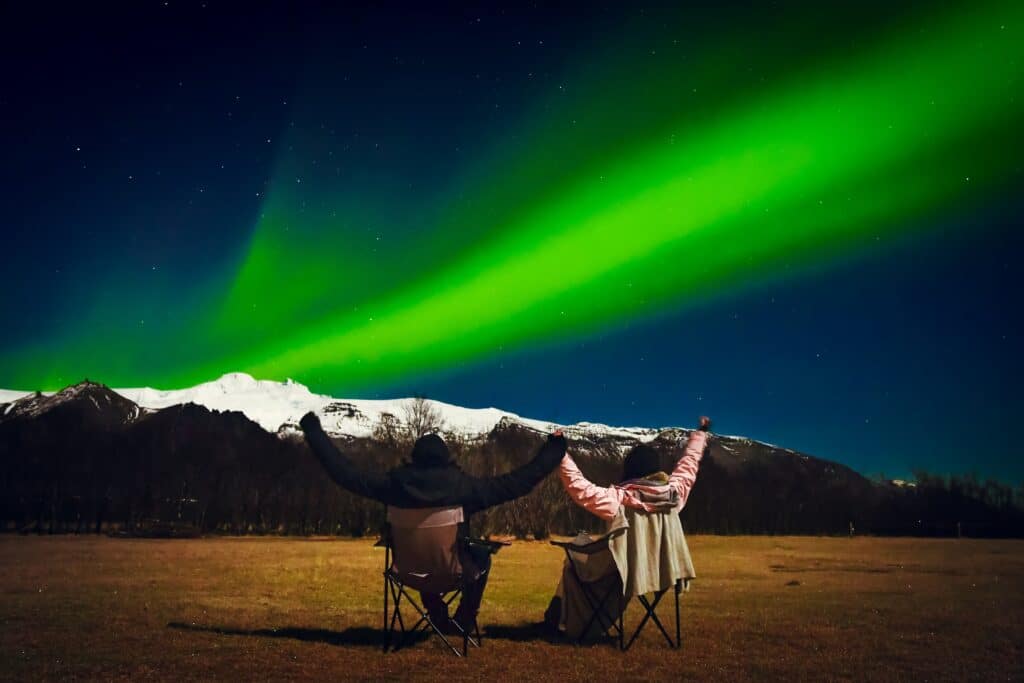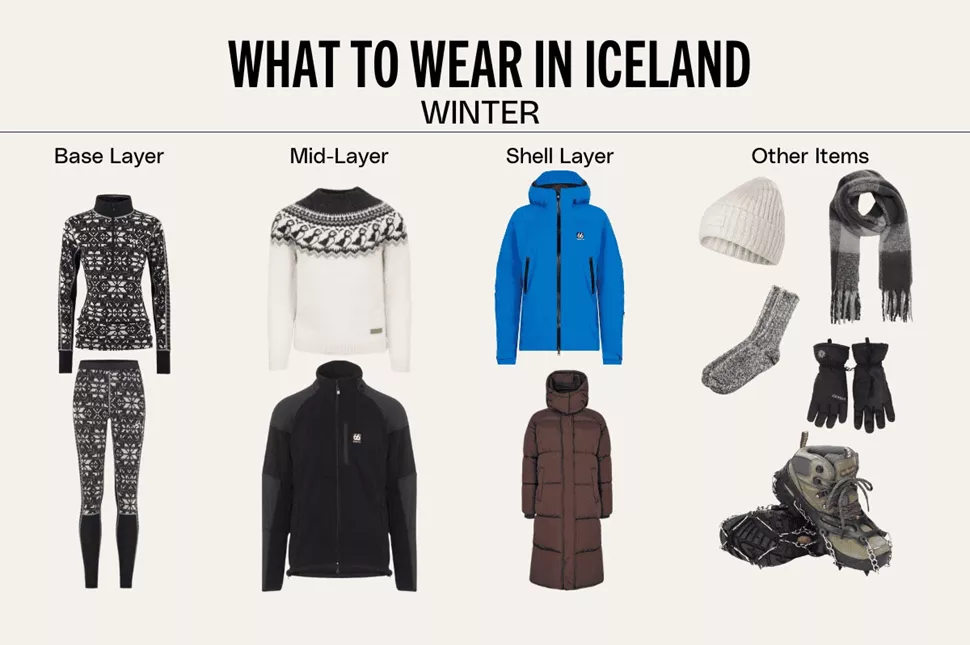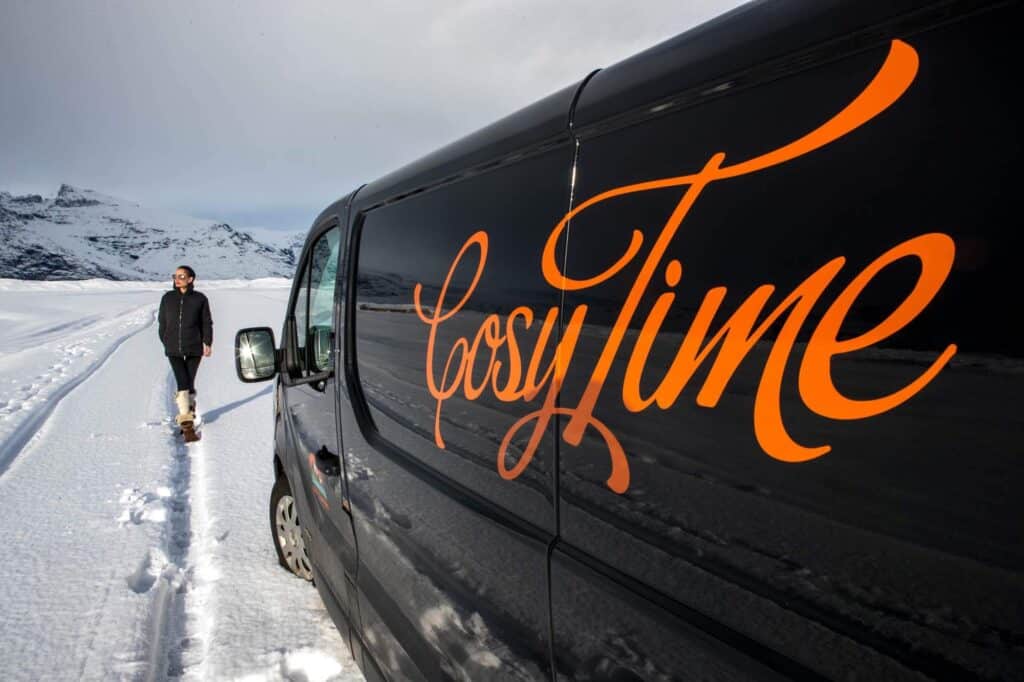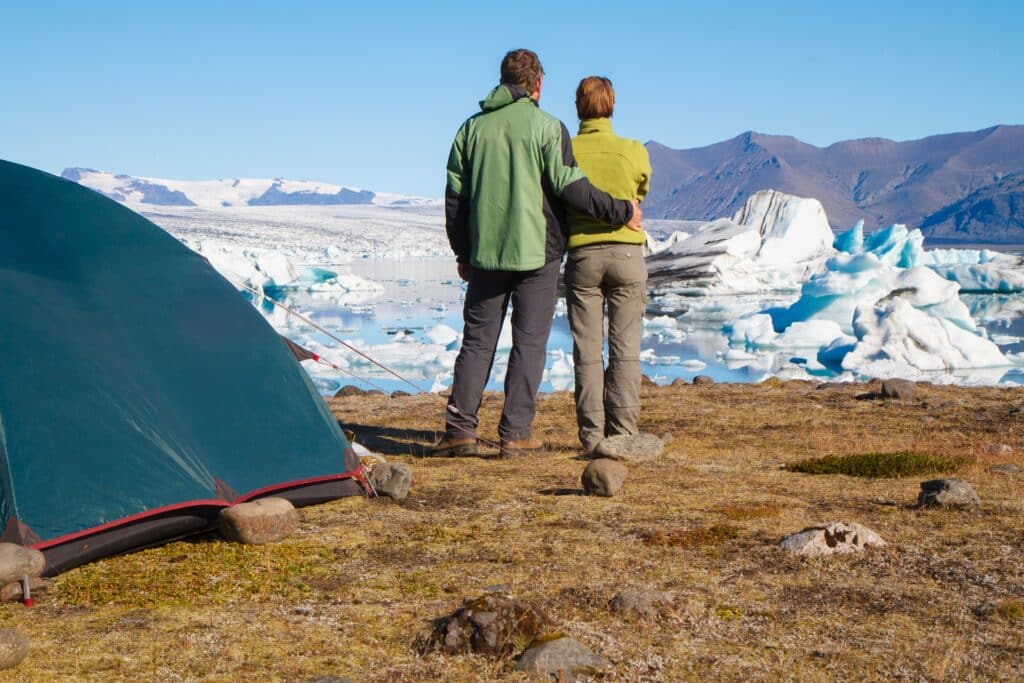
There’s something undeniably magical about winter camping. Picture this: the twinkling stars above, a crisp icy breeze, and the soft crunch of snow underfoot as you set up camp in the heart of Iceland’s dramatic winter landscape. Whether you’re an experienced adventurer or a first-timer drawn to the allure of frosted vistas and the possibility of catching the northern lights, having the right gear can make all the difference. In this guide, we share our top winter camping essentials – the gear you’ll need for those cold nights – to ensure that you stay warm, safe, and fully immersed in the winter wonderland that is Iceland.
Why Winter Camping Is Unforgettable
Winter camping isn’t just about enduring cold nights – it’s about embracing the season’s unique beauty and tranquility. Here’s what makes it so special:
- Stunning Landscapes: Iceland transforms into a serene, snow-dusted wonderland in the winter. Frozen waterfalls, glistening glaciers, and vast expanses of white create a surreal atmosphere.
- Northern Lights: The long nights provide the perfect backdrop for the aurora borealis. Imagine stepping out of your tent or camper to witness the dancing green and purple lights overhead!
- Quiet Solitude: With fewer crowds than in the summer, you get to enjoy nature uninterrupted. The hush of a snowy landscape, coupled with a crackling campfire, makes for an exceptionally peaceful retreat.
- Unique Experiences: Winter camping often brings unexpected surprises – frosted formations, unique wildlife sightings, and the challenge of navigating ever-changing weather conditions.
While winter camping demands careful planning and preparation, the reward is an immersive experience that stays with you long after you leave.
Planning Your Winter Camping Adventure in Iceland
Just like any adventure, successful winter camping begins with thoughtful planning. Here are some key steps to help you set the stage for a memorable trip:
Check Weather and Road Conditions
Iceland’s weather is notoriously unpredictable. Even if the forecast predicts mostly clear skies, conditions can change rapidly:
- Stay Updated: Use websites like road.is and safetravel.is for real-time updates on weather and road conditions.
- Plan for Delays: Winter days are shorter, and road closures are common. Flexibility in your schedule is key.
Choose the Right Vehicle or Shelter
For many adventurers, the decision is not just about what to pack but also where to sleep. While traditional tent camping is an option, we’ve seen more travelers opt for winter-ready campervans to enhance their journey:
- Cozy Campers Advantage: Our fleet includes models that are built to beat the winter chill. With vehicles like the Highlander series and Cozy models equipped with features such as the Webasto heating system, panoramic view windows, and insulated interiors, you can explore Iceland without sacrificing comfort.
Map Out Your Route and Campsites
Plan your itinerary with extra care during winter:
- Campsite Research: Many campsites in Iceland are seasonally open, so knowing which ones offer facilities like hot showers and electricity during winter is essential.
- Alternate Plans: Have backup locations in mind in case your chosen campsite is full or if weather conditions force you to change your route.
Safety First
- Let Someone Know: Always share your itinerary with a friend or family member.
- Emergency Kit: Pack an emergency kit that includes a first aid kit, extra food supplies, and a fully charged mobile phone with a power bank.
Winter Camping Gear Essentials: Clothing and Personal Gear

When it comes to winter camping, layering is the name of the game. Dressing appropriately is your first line of defense against the cold. Here’s what you should pack:
1. Base Layers: The Foundation
Your base layer is crucial for wicking moisture away from your skin. Look for materials like merino wool or synthetic fabrics:
- Merino Wool Shirts and Leggings: Breathable, moisture-wicking, and naturally odor-resistant.
- Thermal Underwear: Long johns or thermal tops that fit snugly to trap heat.
2. Insulation Layer: Keeping You Warm
Your second layer should trap heat effectively:
- Fleece or Down Jackets: Lightweight yet warm, these are essential during freezing temperatures.
- Insulated Pants: Consider thermal-lined pants if you expect very low temperatures.
- Sweaters or Wool Pullovers: Great for casual wear around the campsite or extra warmth during sleep.
3. Outer Layer: Protection from the Elements
The outer layer should protect against wind, rain, and snow:
- Waterproof and Windproof Jacket: Ensure it has a hood for added protection.
- Water-Resistant Pants: These help prevent moisture from chilling you.
4. Accessories
Don’t overlook these small yet critical additions:
- Gloves and Mittens: Waterproof, insulated options are best.
- Hat and Balaclava: A warm hat that covers your ears, and a balaclava if you face very windy conditions.
- Thermal Socks and Insulated Boots: Keep your feet warm and dry; consider doubling up on socks.
- Neck Gaiter or Scarf: To protect your neck and face from biting winds.
By mastering the art of layering, you can easily adjust your clothing as temperatures and activities change throughout the day.
Winter Camping Gear Essentials: Sleeping Comfort
A good night’s sleep is vital, especially when you’re battling cold conditions in the wild. Consider these essentials to ensure maximum comfort:
1. A Quality Sleeping Bag
Your sleeping bag should be rated for temperatures well below what you expect to encounter:
- Temperature Rating: Look for bags rated to at least -10°C or lower. If you tend to feel cold at night, err on the side of caution.
- Down vs. Synthetic: Down is lighter and more compressible, but synthetic insulation performs better in damp conditions. Choose based on the expected environment in your camping spot.
2. Insulated Sleeping Pad
An insulated pad is crucial as it prevents body heat from escaping to the cold ground:
- Self-Inflating or Foam Pads: Look for options that provide a good balance of comfort and insulation.
- Extra Padding: In extreme conditions, consider adding an extra layer for cushioning and warmth.
3. Extra Blankets and Linens
Even in a well-insulated sleeping bag, an extra layer can never hurt:
- Cozy Campers Advantage: For those who prefer the comfort of a van, our campers come with high-quality goose down duvets, pillows, and blackout curtains with magnets to keep the cold out while you sleep.
By investing in the right sleeping gear, you transform your winter camping experience from a test of endurance into a restful retreat, even when the night air is freezing.
Winter Camping Gear Essentials: Shelter, Tents, and Campervans

When nature isn’t kind with the weather, where you sleep becomes as important as what you pack. Let’s explore your options:
1. Traditional Tents for Winter
If you prefer the classic camping experience, ensure you have a four-season tent designed for harsh conditions:
- Sturdy Construction: Look for tents with robust poles and high wind resistance.
- Proper Ventilation: Prevent condensation by choosing tents with adjustable vents.
- Snow Stakes and Reinforcements: Essential for securing your tent in high winds and snowy conditions.
2. Campervan or Motorhome Options
For those who want a little extra warmth and convenience, campervans are a game changer:
- Cozy Campers’ Fleet: Our 4×4 campers, like the Highlander I, II, and III from our Premium or Budget lines, offer panoramic sky roofs, raised chassis for better ground clearance, and tailor-made heating systems (like the Webasto heating system) that are ideal for winter adventures.
- Built-In Comfort: With features like sink with running water, gas stoves with an extra gas bottle, and refrigerator/cooler units, our campers are designed to make winter camping feel like a home away from home.
- Safety and Navigation Aids: Equipped with Bluetooth radios, back cameras, and several USB charging ports, our vehicles ensure that you remain connected and safe no matter how far off the beaten track you roam.
Choosing between a tent and a campervan depends on how much you value the extra comfort and protection from the elements. For many travelers in Iceland during winter, the balance tips in favor of a camper, allowing you to explore the rugged outdoors without compromising on warmth and convenience.
Winter Camping Gear Essentials: Cooking and Heating Equipment
Nothing beats a hot meal and a warm drink after a day in the cold. Having the right cooking and heating gear can elevate your winter camping experience:
1. Portable Gas Stove and Cooking Gear
- Reliable Stove: A gas stove is essential. Make sure you have at least one extra gas bottle – this is standard in most Cozy Campers models.
- Cookware and Kitchenware: Pack pots, pans, a kettle, and utensils that are designed to handle low temperatures.
- Wind Shield: Consider a windscreen for your stove. Wind can drastically reduce the efficiency of any portable heater or burner.
2. Heating Solutions
- Campfire: If conditions allow and it’s permitted, a safely contained campfire can be both a cooking tool and a source of warmth. Always adhere to local guidelines and fire safety rules.
- Supplementary Heating: If you’re staying in a tent, portable heaters designed for camping (and that are safe for indoor use) can help boost the temperature. However, if you’re using one of our Cozy Campers, you can rely on its built-in Webasto heating system – designed to thaw out even the frostiest nights.
3. Warm Drinks and Snacks
- Insulated Mugs: Keep your coffee, tea, or hot chocolate hot with an insulated travel mug. We all know how refreshing a warm drink can be in the middle of a cold winter night.
- High-Energy Snacks: Pack snacks like nuts, chocolate, or granola bars. These provide instant energy and help maintain body temperature during chilly evenings.
With the convenience of a camper equipped with a high-quality stove, refrigerator, and even charging stations for your devices, cooking in the wilderness becomes a pleasure rather than a chore.
Winter Camping Gear Essentials: Navigation and Safety Tools
Even the best-planned winter camping trip requires a solid set of safety and navigation tools. Here’s what you shouldn’t leave behind:
1. Navigation Devices and Maps
- GPS and Maps: While smartphones are great, having an offline GPS device and detailed maps is essential – especially in areas where cell service might be spotty.
- Compass and Local Guides: For traditionalists, a compass and an updated local guide book can help navigate tricky terrains.
2. Lighting Options
- Headlamps and Flashlights: Hands-free lighting is crucial. Make sure you have extra batteries.
- Portable Lanterns: A battery-powered lantern can illuminate your campsite and make it easier to move around safely at night.
3. Communication and Emergency Kits
- Fully Charged Mobile Phone: Always keep your phone charged, along with a spare power bank or extra battery.
- First Aid Kit: Your kit should include essentials to treat minor injuries, as well as items like blister treatments and pain relievers.
- Multi-Tool: A high-quality multi-tool that can handle unexpected repairs or adjustments is invaluable.
- Emergency Blanket: Compact and lightweight, these blankets can provide essential warmth in emergencies.
These tools, along with letting someone know your itinerary, form the backbone of a safe and secure winter adventure.
How Cozy Campers Enhance Your Winter Camping Experience

At Cozy Campers, we truly understand that the harsh winter conditions in Iceland call for more than just a well-packed backpack. Our campers are designed with winter adventures in mind, providing a secure, warm, and comfortable home base no matter how low the temperatures drop.
Built for the Cold
- Premium Heating Systems: Our campers, including models like the Highlander I, II, and III as well as the Cozy 1 and Cozy 3 (available in both automatic and manual variants), feature robust Webasto heating systems that keep you warm throughout the night. This means no matter how cold it gets outside, you’ll always have a toasty sanctuary waiting for you.
- Insulated Interiors: With features like panoramic view windows, blackout curtains, and insulated sleeping setups (equipped with goose down duvets and multiple pillows), our campers create an environment where you can relax and recover after a long day on the snowy roads.
- Robust and Reliable: Designed for Iceland’s unpredictable winter roads, our 4×4 models come with raised chassis, larger tires, and extra battery power. Whether you’re venturing on main roads or sometimes needing to take a detour on less-traveled winter routes, you can count on Cozy Campers to get you there safely.
- Convenience Factors: From built-in sinks with running water to gas stoves, refrigerators, and a full complement of kitchenware, our campers eliminate the need to lug around extra equipment. This means you can focus on enjoying the winter landscapes rather than worrying about setting up a makeshift kitchen in the cold.
The Cozy Campers Difference
- Ease of Booking: With a range of models to suit different group sizes and budgets – from the budget-friendly Cozy 1 (Manual and Automatic) to the more spacious Highlander III – you’re sure to find the perfect camper for your winter adventure.
- Customer Support: Our team is always ready to provide advice and ensure you have all the information you need before your journey, whether it’s about the right insurance options (like our optional Gravel, Sand & Ash, and Tire Protection plans) or tips for winter driving.
- Added Extras: Stay connected with our optional add-ons such as tablet and 4G WiFi rentals, power inverters for charging your devices, and even camping chairs and tables to enhance your outdoor dining experience.
We’re passionate about making your winter camping experience as hassle-free and memorable as possible. With our vehicles at your service, you’re not just renting a camper – you’re investing in a comfortable, safe, and warm retreat that moves with you.
Our Personal Tips for a Successful Winter Camping Trip
Having spent countless nights under the Nordic skies, we’ve learned a few tricks along the way. Here are some personal tips to ensure your winter camping trip is both safe and exhilarating:
- Plan for Longer Nights: Winter days are short. Pack extra food, water, and fuel – both for cooking and for your vehicle – to ensure you’re never caught off guard.
- Stay Dry: Moisture is your enemy in cold weather. Always carry waterproof bags for your clothes and electronics.
- Mind the Wind: Strong winds can chill you to the bone, so setting up your shelter in a less exposed area (or choosing a camper with a secure, insulated build) is critical.
- Relaxation is Key: After a long day outdoors, take time to relax. A warm cup of your favorite beverage in the cozy interior of your camper can make all the difference.
- Keep Moving: Even a light walk or some gentle exercises will help keep your blood circulating and stave off the chill.
- Check on Others: If you’re traveling in a group or even by yourself, always let someone know your plans. Safety is the utmost priority when you’re venturing into remote, wintry landscapes.
What We Pack for Our Winter Camping Trips
To give you an idea of what to bring, here’s a checklist of some of our must-haves:
- Clothing:
- Thermal base layers (merino wool tees and leggings)
- Insulated fleece or down jacket
- Waterproof, windproof outer jacket and pants
- Insulated gloves, hat, and neck gaiter
- Thermal socks and waterproof boots
- Sleeping Gear:
- A high-quality sleeping bag rated for at least -10°C
- Insulated sleeping pad
- Extra blankets and warm linens (if you’re not using a camper’s pre-equipped bedding)
- Cooking Essentials:
- Portable gas stove with an extra gas bottle
- Pots, pans, utensils, and a kettle
- Insulated travel mug for hot drinks
- Navigation and Safety:
- GPS device with offline maps
- Headlamps, flashlights, and portable lantern
- First aid kit and multi-tool
- Emergency blanket and power bank
- Extras:
- Waterproof bags for electronics and spare clothes
- Personal items such as toiletries, a camera for capturing snowy landscapes, and a good book for quiet evenings
- A detailed itinerary left with a friend or family member
This list is by no means exhaustive, but it covers the basics that will keep you warm, safe, and comfortable on even the chilliest of nights.
Conclusion

Winter camping in Iceland is as exhilarating as it is challenging. With the right preparation and gear, those long, frosty nights can be transformed into warm, unforgettable memories. From meticulously planning your route and checking weather updates to layering up in the right clothing and ensuring a cozy sleeping space, every detail plays a role in the success of your adventure.
At Cozy Campers, we are passionate about enabling your exploration of Iceland’s winter wonderlands – without compromising on the comfort and safety you deserve. Our range of winter-ready campers, featuring robust 4×4 builds, advanced heating systems, and thoughtful amenities, provides you with the perfect retreat after a day of chasing frozen waterfalls, exploring snowy fjords, or simply marveling at the northern lights.
So, whether you’re setting up a traditional winter tent or opting for the warmth and convenience of a Cozy Camper, remember: the secret to a successful winter camping trip is proper preparation. Gear up with the essentials, plan ahead, and let your adventure begin. We can’t wait to be a part of your journey.
Ready to embrace a winter wonderland like never before? Plan your winter camping escapade with us at Cozy Campers and experience cold nights that feel surprisingly warm. Happy camping!
Back to blog